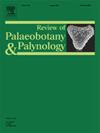二叠纪前花粉属Nuskoisporites的年代地层和古地理分布的再评价
IF 1.7
3区 地球科学
Q2 PALEONTOLOGY
引用次数: 0
摘要
Nuskoisporites属是二叠纪孢粉植物的共同组成部分,具有重要的生物地层学和古地理意义。尽管已有对其产状的修正,但其完整的地层范围和古地理分布仍存在不确定性。本研究对历史记录进行了全面的回顾,并辅以来自10个不同地理区域的446个Nuskoisporites标本的新的形态测量数据。采用主成分分析法(PCA)对3个形态计量变量进行了测量和分析:总大小(直径)、总大小与中心体直径之比(P:CB)和中心体直径与平均体长之比(CB:L)。根据这些特征可以区分出两种形态,每种形态表现出不同的地层范围。较老的形态跨越宾夕法尼亚纪至下瓜达鲁普纪,而较年轻的形态则局限于上西苏拉纪至洛平纪。目前的证据支持Nuskoisporites在二叠纪-三叠纪界线之前或附近的灭绝,从而反映了真正的生态更替,而不是重新加工或保存的偏见。古地理和古生态分析表明,Nuskoisporites最初在多个植物省和纬度具有广泛的分布。然而,在洛平纪期间,其地理分布明显减少,将花粉限制在特提斯西部边缘的低纬度地区,与全球干旱化和环境压力加剧相一致。Nuskoisporites的这种综合方法为该属提供了一个精细的地层范围,并为其在石炭纪和二叠纪末期的生态动态提供了新的见解。本文章由计算机程序翻译,如有差异,请以英文原文为准。
Reassessment of the chronostratigraphic and paleogeographic distribution of the Permian prepollen genus Nuskoisporites
The genus Nuskoisporites is a common component of Permian palynofloras, with biostratigraphic and paleogeographic importance. Despite the existence of previous revisions of its occurrence, there are still uncertainties concerning its complete stratigraphic range and paleogeographic distribution. This study presents a comprehensive review of historical records, complemented by new morphometric data derived from 446 Nuskoisporites specimens representing ten geographically distinct regions. Three morphometric variables were measured and analyzed using Principal Component Analysis (PCA): total size (diameter), the ratio of total size to central body diameter (P:CB), and the ratio of central body diameter to average laesurae length (CB:L). Two morphotypes can be distinguished based on those characters, each exhibiting different stratigraphic ranges. The older morphotype spans the Pennsylvanian to lower Guadalupian, while the younger form is confined to the upper Cisuralian through Lopingian. Current evidence supports the extinction of Nuskoisporites shortly before or at the Permian–Triassic boundary, thereby reflecting a genuine ecological turnover rather than reworking or preservation bias. Paleogeographic and paleoecological analyses indicate that Nuskoisporites initially had a broad distribution across multiple phytoprovinces and latitudes. However, a marked reduction of its geographic distribution is observed during the Lopingian, restricting the pollen to low-latitude regions of the western Tethys margin, coinciding with intensified global aridification and environmental stress. This integrated approach of Nuskoisporites provides a refined stratigraphic range for the genus and new insights into its ecological dynamics during the end of the Carboniferous and Permian.
求助全文
通过发布文献求助,成功后即可免费获取论文全文。
去求助
来源期刊
CiteScore
3.50
自引率
21.10%
发文量
149
审稿时长
6 months
期刊介绍:
The Review of Palaeobotany and Palynology is an international journal for articles in all fields of palaeobotany and palynology dealing with all groups, ranging from marine palynomorphs to higher land plants. Original contributions and comprehensive review papers should appeal to an international audience. Typical topics include but are not restricted to systematics, evolution, palaeobiology, palaeoecology, biostratigraphy, biochronology, palaeoclimatology, paleogeography, taphonomy, palaeoenvironmental reconstructions, vegetation history, and practical applications of palaeobotany and palynology, e.g. in coal and petroleum geology and archaeology. The journal especially encourages the publication of articles in which palaeobotany and palynology are applied for solving fundamental geological and biological problems as well as innovative and interdisciplinary approaches.

 求助内容:
求助内容: 应助结果提醒方式:
应助结果提醒方式:


